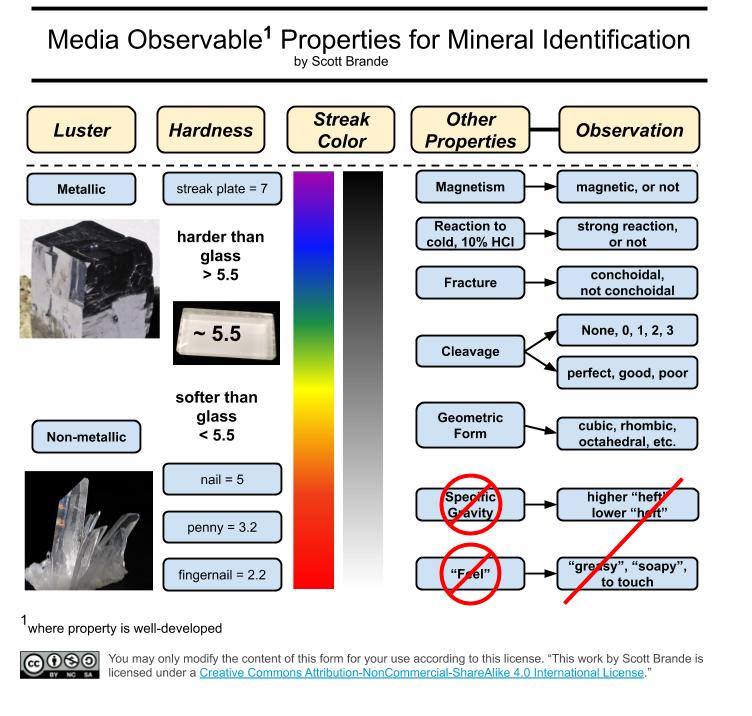Claire Chadwick; Lauren Maurizio; Robin Humphreys; and Vijay Vulava
Minerals and their Properties
Minerals are commonly identified in the field and the lab conducting simple tests for various properties. Many minerals have a unique set of properties that help us identify them by comparing those properties with published data. More detailed investigations (e.g., spectroscopic techniques) are needed to identify complex minerals in some cases. In this lab, we will focus on some of the common minerals discussed in this course.
Exercise 2 – Minerals and their properties
For the minerals listed below, identify the (i) diagnostic properties and (ii) common uses in daily life.
Use the following references to look up the information you need:
- Mineral property bank by Dr. Scott Brande of UAB
- Mineral Kit – GEOS 1111L: Physical Geology Lab Digital Rock & Mineral Kits – Research Guides at University of Arkansas (libguides.com)
- Mineral Properties, Photos, Uses and Descriptions (geology.com)
- Use the following answer template for each mineral as you type your answer: a. Streak Color, b. Luster (metallic, glassy, earthy, etc.), c. Hardness (on Moh’s Scale), d. Cleavage (single plane, multiple planes, fracture pattern), e. special properties (magnetic, salty-taste, effervescence, etc.), f. Common uses (list 2-3 common uses). Create a table as shown here: Mineral-Study-Guide_Data-Form – add Common Uses next to the last column.
- Work as a team to verify data.
- Calcite
- Copper
- Fluorite
- Graphite
- Gypsum
- Hematite
- Magnetite
- Muscovite mica
- Plagioclase feldspar
- Potassium feldspar (microcline)
- Pyrite
- Pyroxene (augite)
- Quartz
- Sulfur
- Talc
Identification of Minerals
There are many mineral specimens in your lab kit – examine these specimens and organize them based on their properties.
- Follow the mineral identification (ID) strategies provided by Dr. Scott Brande at Mineral Study Guide – Testing Minerals (georockme.com).
- Watch the following short videos by Dr. Scott Brande about luster, hardness, color, fracture, cleavage, and magnetism in minerals. The tips from these videos will help you with mineral identification. Work with your group to cross-check the identification.
Exercise 3 – Identify Minerals in the Lab Kit
Identify the following minerals in your kit.
- Use tips from the above videos by Dr. Scott Brande and also the data that you collected to help identify the minerals listed below.
- Conduct the basic identification tests: Streak, Luster, Hardness, Cleavage, Magnetism. (If you have access and inclination, use the effervescence test using vinegar)
- Place the minerals under good natural (window sill or outside) or artificial light on a sheet of white paper (printer paper). Place 4-6 minerals on one sheet of paper and write the name of the mineral next to the mineral.
- Use your phone camera and take a picture from above with steady hands. Embed these pictures in the correct order into a single Word or PDF format document and upload to OAKS in the Assignments section.
- You can use the basic template provided by Dr. Scott Brande as shown below to make your observations:

Figure 1: Template for identifying minerals as developed by Dr. Scott Brande.
- Calcite
- Copper
- Fluorite
- Graphite
- Gypsum
- Hematite
- Magnetite
- Muscovite mica
- Plagioclase feldspar
- Potassium feldspar (microcline)
- Pyrite
- Pyroxene (augite)
- Quartz
- Sulfur
- Talc

